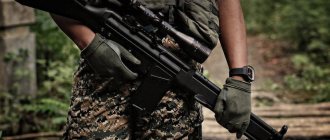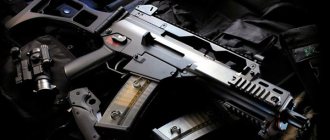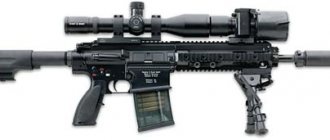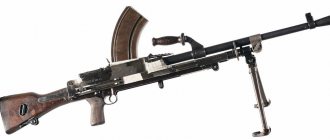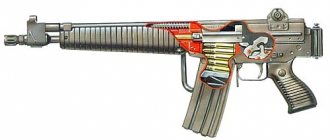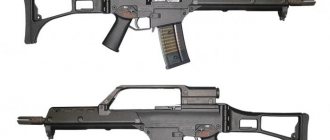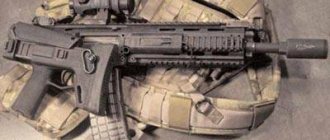Home | Weapons | Anti-tank rifles | Type 97
Japanese firearms have always been distinguished by a more interesting, albeit not always justified, complex design, in comparison with European models or weapons from the United States. It is not easy to answer the question of what exactly forced Japanese designers to complicate designs that should have been simple and reliable. Very often you can come across the opinion that this is due to a low level of knowledge and experience, but looking at individual samples that demonstrate not only a non-standard train of thought, but also realize the limit of technical capabilities, you begin to understand that not everything is so simple and unambiguous.
It cannot be said that Japanese engineers flatly refused to repeat designs developed in other countries. The real reason rather lies elsewhere - the desire to achieve the highest possible characteristics with the technical capabilities of that time, without looking at the issues that will arise during mass production and the cost of the final product. One way or another, thanks to Japanese designers, we can see really interesting, from a technical point of view, solutions, many of which have migrated to other types of weapons, both domestic and foreign.
One of the rather interesting, but completely inconspicuous at first glance, examples of the work of Japanese gunsmiths is the Type 97 anti-tank rifle. This anti-tank rifle is probably one of the most controversial mass-produced ones, both in its design and in the effectiveness of its use. Let's try to get acquainted in more detail with this unusual collection of compromises and technical tricks in attempts to deceive physics.
The history of the Type 97 anti-tank rifle
In fact, in the history of the creation of the Type 97 anti-tank rifle there is no intrigue, no confrontation between designers, nothing at all that ordinary people love so much, but there was an idea. This idea may not have been entirely correct, or rather, not at all correct, as more advanced anti-tank rifles would later show, nevertheless, for its time it was at least relevant.
By the 30s of the last century, it was understood that although an anti-tank rifle is not the most effective means of fighting enemy tanks, it is not at all superfluous on the battlefield, and given the fact that there were no such weapons in the Imperial Army, the PTR it was even necessary. By the same 30s, it was understood that the armor penetration results of the then first anti-tank rifles were not always satisfactory, which means that this issue had to be taken care of in advance in new weapons. Examples from other countries spoke eloquently about this (the very first PTR from Germany Mauser M1918 and later the Swiss PTR SSG 32) Designer Masaya Kawamura proposed one of the cheapest options for solving the issue, namely to design weapons for ready-made ammunition that was in service with the army - 20x124 .
The idea itself was to take obviously powerful ammunition, which with its characteristics would effectively penetrate the armor of tanks existing at that time. In addition, already at that time the range of these cartridges included a high-explosive fragmentation version, which could be used against infantry. Initial tests have shown that the armor-piercing version of the ammunition does not stop even 30 millimeters of armor. In other words, it seemed like an ideal solution, both from a practical point of view and from a financial one, because the production of ammunition had already been established, all that remained was to make a weapon for it.
This very little thing lasted almost 7 years. The main problem, as it unexpectedly turned out, is excessive recoil when firing, which the designers tried to combat by constantly complicating the design, and accordingly losing the overall reliability of the PTR. As a result, in 1937, the command was presented with a new model ready for adoption. Or rather, the sample was presented, but it was not ready. During testing, the Type-97 anti-tank rifle repeatedly experienced delays both during automatic operation and during manual reloading. The weight of the resulting structure was also clearly far from the desired result. The results for accuracy of fire were more than mediocre. But, despite all this, the weapon was accepted, since the armor penetration performance was truly impressive, and the need to close the gap in the army’s armament also played a role.
Design[edit]
Type 97 tank machine gun with optical sight, magazine and protective casing.
The Type 97 was mechanically similar to the Czech ZB vz. 26, with a different stock and pistol grip. It had a 20-round straight vertical box magazine and used the same 7.7 mm cartridges as the Type 99 rifle. The gun barrel could easily overheat, which meant the gunner was firing bursts, or the barrel would be shot off. [2]
When installed in the tank, a fixed 1.5x optical sight with a 30° field of view was used. To avoid injury to the gunner, a rubber eyecup was attached to the rear of the sight.
When used as an infantry weapon, a bipod was used. Without the bipod, it weighed 11.25 kg (24.8 lb). [3]
Design of the Type 97 anti-tank rifle
Of course, the most interesting question remains, what did the designers do that was so supernatural to curb the recoil of a fairly powerful ammunition? We can say that we did everything possible, but it turned out to be not enough, which will be discussed below.
Brief characteristics of the 20x124 armor-piercing ammunition were as follows. A bullet weighing 132 grams accelerated to a speed of 950 meters per second, that is, the kinetic energy of the bullet was slightly less than 60 thousand Joules.
In order to compensate for recoil when firing, the designers used several solutions at once. The barrel, receiver, and, accordingly, the bolt group were assembled into one unit, which had the ability to roll back, compressing the spring. However, this turned out to be not enough, even despite the overall significant mass and stiffness of the damper spring. In order to reduce the kinetic energy of the moving group, a muzzle brake-recoil compensator was installed on the muzzle, which significantly reduced the speed of movement. But 60 thousand Joules is 60 thousand Joules and it’s not so easy to deal with them. In addition to these solutions, the shooter's shoulder rest was equipped with a separate spring shock absorber and had a thick pad. The anti-tank rifle itself was mounted on a bipod and had an additional support under the butt.
The weapon's automation is built according to a scheme with the removal of powder gases from the barrel bore; locking occurs by moving the locking wedge in a vertical plane. Questions are raised by two pistons in the gas engine of the weapon. The reason for this decision lies not even in the excess pressure of the powder gases (a regulator is provided for this purpose), but in the banal layout of the weapon. The thing is that the magazine with cartridges is attached to the top of the receiver, and the spent cartridge is ejected downwards, taking into account the massiveness of the entire structure, placing one piston strictly to the left or right of the bolt group will one way or another lead to increased wear, and then to failures due to distortions. It is clear that it is impossible to position one piston strictly above or below. By placing two pistons under the bolt group, it was possible not only to evenly distribute the load during reloading, but also to solve the issue of extracting the spent cartridge case downwards.
You can often find information that this anti-tank gun had the ability to fire automatically. But you don’t need to be a genius to understand that with exorbitant recoil, even with a single fire, it would be at least difficult to conduct automatic, much less targeted automatic fire. The very information about the possibility of firing in bursts originates from the idea of creating a paired installation of two anti-tank rifles, which could conduct automatic fire and were fed from magazines with a capacity of 30 rounds. The resulting monster did not go beyond the experimental model.
Characteristics of the Type 97 anti-tank rifle
The total length of the Japanese Type 97 anti-tank rifle was 2100 millimeters, with a barrel length of 1250 millimeters. The weight without carrying handles, armored shield and ammunition was 50 kilograms, and when fully equipped the weight increased to 68 kilograms. Food is supplied from detachable magazines with a capacity of 7 rounds. Various sources indicate the rate of fire from 10 to 25 rounds per minute. In practice, this value, first of all, depended on the physical data of the calculation of the anti-tank rifle.
General assessment of the effectiveness of the Type 97 PTR
It is quite difficult to evaluate the Type 97 anti-tank rifle, since the weapon turned out to be very unique even for its class. The very idea of an anti-tank rifle is based on the mobility of the crew and weapons, while quickly moving from position to position while carrying almost 70 kilograms plus ammunition is quite difficult. An interesting point is that the handles for carrying weapons are designed so that at least 3 people will carry the PTR, while the crew usually consisted of two people. It was for this reason that weapons were used in previously prepared positions and were very rarely moved during the battle. Considering that after the first shots the location of the anti-tank gun became known to the enemy, this can be considered a very significant disadvantage.
But what was even worse was that the PTR, even despite all the technical solutions to reduce recoil when firing, kicked in a way that no Arabian horse can kick. In the crews of anti-tank rifles, there were frequent cases of serious shoulder injuries due to the recoil of the weapon. The soldiers themselves, in order to cope with weapons, were forced to resort to various tricks. Thus, a frequent practice was to press the shooter to the ground with the weight of the second number from the calculation.
The Japanese anti-tank rifle was not distinguished by high accuracy, which was also clearly not a “plus” for the weapon. Despite the high armor penetration rates for its class, there were often cases when a hit and penetration did not in any way affect the performance of the tank or armored vehicle. The hit did not damage any important components and did not harm the crew. Taking into account the low rate of fire, low mobility and short range of use of weapons, all this reduced the effectiveness of anti-tank guns on the battlefield, however, the Type 97 was not useless.
Both domestic armored vehicles in the battles of Khalkhin Gol and American armored vehicles in the Pacific Islands were able to verify this. At a distance of 250 meters, when hit at an angle of 90 degrees, the ammunition was capable of penetrating up to 30 millimeters of armor, making not only a beautiful hole in the armor plate, but also knocking out fragments from it on the back side, but still this was not enough. Lack of ability to quickly change position was the main reason for the death of anti-tank rifle crews. You can often come across the opinion that an anti-tank mine on a pole in the hands of a soldier was much more effective, and, unfortunately, this statement is not far from the truth.
In total, about 1,200 anti-tank rifles were produced, some of them became trophies, some solutions were already used in other models of weapons, other classes. With the advent of armored vehicles with stronger and thicker armor, even these anti-tank rifles lost their only advantage in the form of reliable penetration.
Anti-tank rifles
- Mauser T-Gewehr M1918
- SSG 32 / SSG 36
- Type 97
- PTR Maroshek
- PTR Solothurn S18
- Boys Anti-Tank rifle
- Lahti L-39
- Madsen 1935 (Denmark)
- PTR RES (USSR)
- W/15 and W/7.92 (Czechoslovakia)
- PTR Kurchevsky (USSR)
- PTR Vladimirov (USSR)
Notes[edit]
- ↑
Bishop, Encyclopedia of World War II Weapons. - [1] TM-E 30-480 (1945)
- Data cards at the Sinbudai Old Weapons Museum, Camp Asaka, Japan
- [2] Dragonsofire.com
- ↑
Morse,
Japanese Small Arms of World War II; Light machine guns models 11, 96, 99, 97 and 92 - Kinard, Jeff (April 9, 2010). "Machine guns". In Tucker, Spencer C.; Pierpaoli, Paul G., Jr. (ed.). Encyclopedia of the Korean War: Political, Social and Military History. 1. A.L. (2nd ed.). ABC-CLIO. p. 535. ISBN 978-1-85109-849-1.
Advantages and disadvantages
Knowing the most important strengths and weaknesses will come in handy more than once in battle, because based on an understanding of such nuances, tactics are built and, in addition, it will be easier for you to select equipment and decide on the choice of skills. Now we will determine the advantages and disadvantages of the Type 97 Chi-Ha WoT
, breaking them down into separate points: Pros: • Good basic overview; • Powerful one-time damage; • High damage per minute; • Excellent penetration rates; • Comfortable vertical aiming angles. Cons: • Weak armor in all projections; • Low camouflage coefficient; • Mediocre mobility; • Poor accuracy rates.
Links[edit]
- Bishop, Chris (editors) (1998). Encyclopedia of World War II Weapons
. Barnes and Nobel. ISBN 0-7607-1022-8.CS1 maint: additional text: list of authors (link) - Mayer, S. L. (1984). The Rise and Fall of Imperial Japan. Military press. ISBN 0-517-42313-8.
- Morse, D.R. (1996). Japanese small arms from World War II;
Light machine guns models 11, 96, 99, 97 and 92 . Firing Pin Companies. ASIN: B000KFVGSU. - Popenker, Maxim (2008). The Machine Gun: The Development of the Machine Gun from the Nineteenth Century to the Present. Crowd. ISBN 978-1-84797-030-5.
- Rottman, Gordon L. (2005). Japanese infantryman 1937-1945
. Osprey Publishing. ISBN 1-84176-818-9. - US Department of War (1994). Handbook of the Japanese Armed Forces, TM-E 30-480 (1945)
(reprint). Louisiana State University Press. ISBN 0-8071-2013-8.
gun
If, after analyzing the general characteristics, the picture emerges is not at all reassuring, then the armament makes it clear that the machine in our hands is not at all easy, because its gun is really good.
First of all, the Type 97 Chi-Ha has a gun
has a powerful one-time damage and if you combine it with a really good rate of fire, we can boast of an impressive damage per minute, which is 1400 units without any equipment and perks.
Even more pleasing are the penetration rates of this weapon, because even using only conventional armor-piercing shells Type 97 Chi-Ha WoT tank
capable of confidently inflicting damage on all classmates and level 4 vehicles. Problems can only arise with fives, so don’t skimp on buying 10-15 gold BBs.
Another highlight of our gun is its excellent elevation angles, because our barrel is a Japanese medium tank Type 97 Chi-Ha
capable of lowering as much as 15 degrees down, which is good news.
Perhaps the only disappointment in terms of weapons is the accuracy parameters, since our spread is very large, stabilization is poor and convergence takes a long time. But these missteps of the Type 97 Chi-Ha World of Tanks
can be corrected by properly training the crew and installing the appropriate additional modules.
